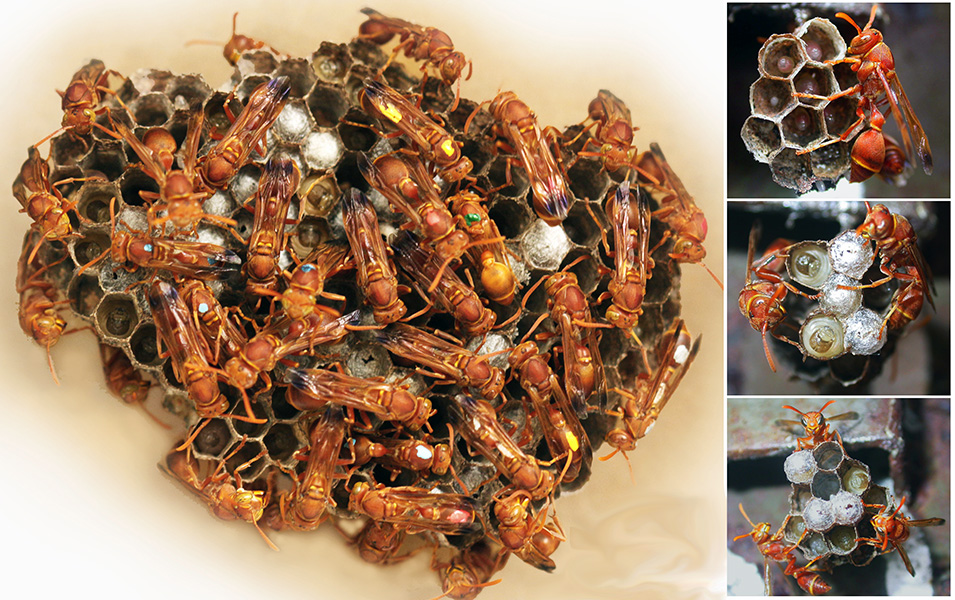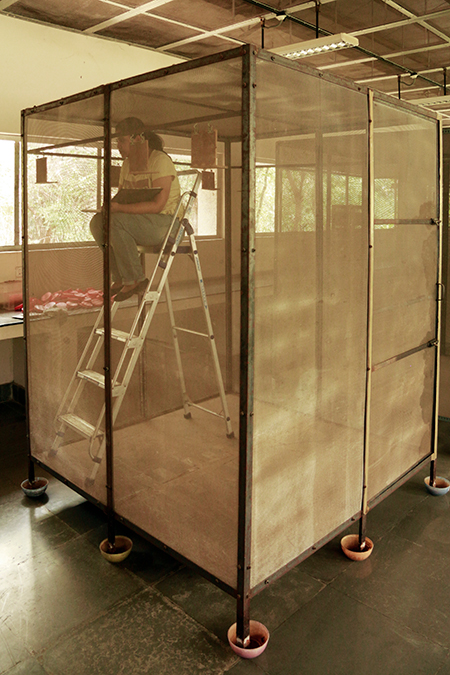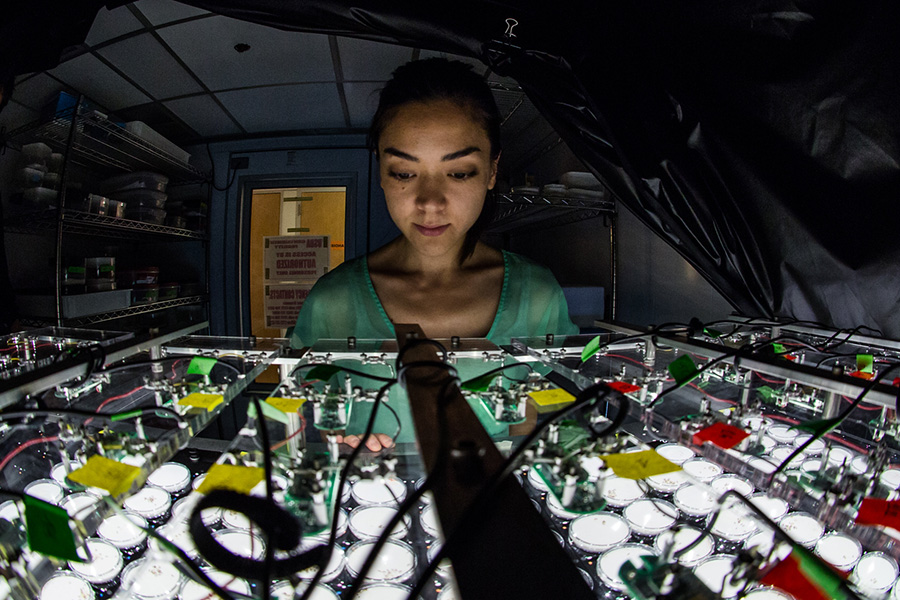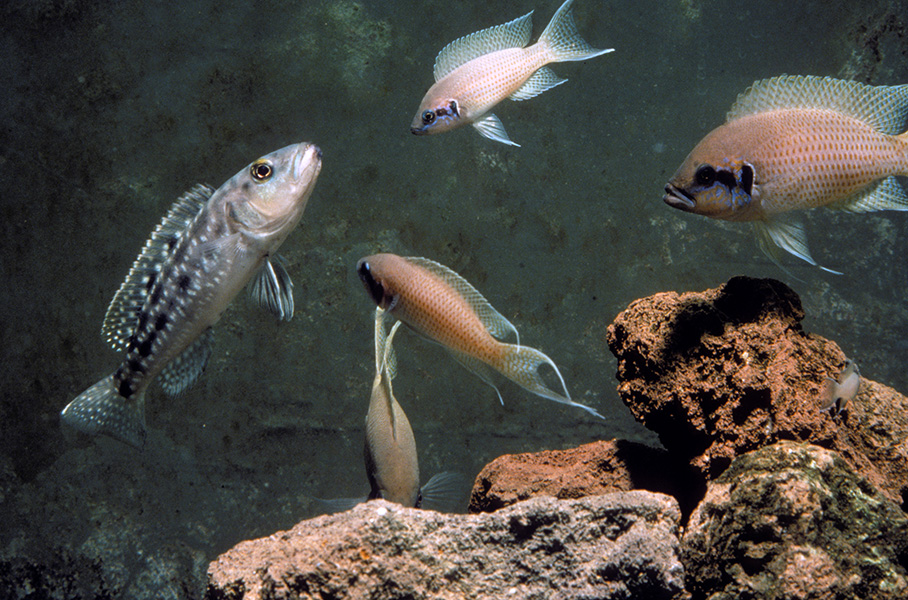Division of labor in ants, wasps, bees — and us
Social insects and humans share the trait of divvying up tasks, as do some fish. Researchers find that it emerges naturally, and it often doesn’t take a boss to keep things in order.
Support sound science and smart stories
Help us make scientific knowledge accessible to all
Donate today
For humans, division of labor has become a necessity: No person in the world has all the knowledge and skills to perform all the tasks that are required to keep our highly technological societies afloat. This has made us entirely dependent on each other, leaving us individually vulnerable. We really can’t make it on our own.
From archaeological findings, we can reconstruct more or less how this situation evolved. Initially, everyone was doing more or less the same thing. But because food was shared among people living in hunter-gatherer groups, some were able to specialize in tasks other than finding food, such as fashioning tools, treating illnesses or cultivating plants. These skills enriched the group but made the specialists even more dependent on others. This further reinforced cooperation among group members and pushed our species to even higher levels of specialization — and prosperity.
“Societies that have highly developed task-sharing and division of labor between group members are conspicuous because of their exceptional ecological success,” says Michael Taborsky, a behavioral biologist at the University of Bern in Switzerland. And he doesn’t just mean us: Extensive division of labor also can be seen among many social insects — ants, wasps, bees and termites — in which individuals in large colonies often specialize in particular tasks, making them impressively effective.
“It is no exaggeration,” Taborsky says, “to say that societies” — of both humans and social insects — “predominate life on Earth.”
But how did this division of labor evolve? Why does it seem to be rare outside of our species and the social insects? Is it, in fact, as rare as it seems?
Taborsky, who has studied cooperation in animals for decades, has become increasingly interested in these questions. In March 2023, he and Barbara Taborsky, his wife and colleague, organized a scientific workshop on the topic in Berlin to which they invited a number of other experts. Over the course of two days, the group discussed how division of labor may have evolved over time, and what mechanisms allow it to develop, over and over again, in every colony of certain species.

To identify individual ants — which look very much the same, even to the most experienced ant biologist — researchers mark the creatures’ bodies with different-colored paints.
CREDIT: ANNA SCHROLL
One of the invited scientists was Jennifer Fewell, a social insect biologist at Arizona State University who coauthored an influential overview of division of labor in the Annual Review of Entomology in 2001 and has studied the subject for decades. In social insect colonies, she says, “there is no central controller telling everybody what to do, but instead, the division of labor emerges from the interaction between individuals.”
At a very basic level, that emergence might be driven solely by variation in how sensitive individuals are to certain features of their environment, Fewell says. Take, for example, the question of who does the dishes. Some people cannot stand dirty dishes in the sink; others don’t notice them until they stack up. “In my case, that happens when they fill about half of the sink. In the case of my spouse … it’s two dishes,” Fewell says. “So each time, he will get to the point where there are two dishes in the sink and wash them, thereby reducing my need to do it, because the dishes will never reach my response threshold.”
To understand how division of labor may have originated, Fewell adds, it probably doesn’t make sense to study the very complex social insect societies that have different castes of workers with highly adapted and sometimes wildly different body shapes and sizes. They’re just too established and complicated. The best strategy, she suggests, is to focus on related species in which individuals are usually solitary or have a simpler society in which members are very similar and all have the possibility to develop into a queen, meaning fates are still flexible.
One species that Fewell has worked with is a sweat bee of a ground-nesting species (Lasioglossum NDA-1) that she collected from a forest in southern Australia and that hasn’t been formally described yet. These bees are normally solitary. But when they are forced to live together in an artificial nest, they will naturally divide the work of excavating and guarding it, simply because individuals differ slightly in their tendencies to do one job or the other. “This does not mean they are coordinating,” Fewell says. “Sometimes, the bee that is excavating may cover the other one in dirt.… They aren’t paying that much attention to each other.”
In other words, even in the absence of any apparent coordination, a very rudimentary form of division of labor may emerge.
Since they are solitary, however, these sweat bees can teach us relatively little else about what it takes to divide up work. So Fewell is studying other species that have varying degrees of social behavior. In some populations of the California harvester ant (Pogonomyrmex californicus), colonies are founded by single queens, while in other colonies, multiple queens tend to collaborate. Would that make a difference in how they behave?
It does. When Fewell combined queens from single-queen populations with ones from a multiple-queen population, those from the multiple-queen population certainly appeared to be paying more attention to what other queens were doing. But that didn’t mean they acted more helpfully or selflessly. In fact, says Fewell, the opposite often proved true. “In most cases, the normally solitary queen naively does all the digging, which is a risky task,” she says. “Meanwhile, the social one stays in the nest and looks after all of the eggs” — a much safer job.
So even though division of labor can emerge by itself, it isn’t necessarily beneficial at first, at least not for everyone involved.
Studies in other species have also shown that division of labor does not necessarily mean playing nice, said behavioral ecologist Raghavendra Gadagkar of the Indian Institute of Science in Bangalore, another participant at the meeting. In Indian paper wasps, a colony-living social species he has studied for decades, individuals do not differ in body shape and every female has the capacity to develop ovaries and grow into a queen. But in the lab, when two females are placed in a little plastic box together, one individual in every duo harasses the other to prevent ovary development and compel her into the role of a worker.

In the Indian paper wasp Ropalidia marginata, all individuals have the ability to develop into queens, but frequent harassment ensures that only some of them do. On the left, a mature nest built by a normal colony. On the right, nests built by artificial colonies consisting of only one, two or three females.
CREDIT: MATURE NEST – SOUVIK MANDAL; NEWLY INITIATED NESTS – THRESIAMMA VARGHESE
Especially intriguing is what happens when Gadagkar and his collaborators put three females together. “There will still be only one queen, but the two workers will now also divide the labor,” he says. “One will take care of the brood inside the nest, the other will go out to forage…. After the initial phase, the queen will leave it to workers to enforce this division of labor.”
Further experiments have revealed that the more individuals in a nest, the more refined and productive division of labor becomes. While there is little difference in the number of eggs and larvae that are born and survive within a nest with one or two individuals, adding a third leads to roughly one-third more eggs, pupae and larvae produced in the nest. So not only does division of labor readily emerge, it also clearly has benefits, and these continue to increase with colony size, at least up to a point.
In the wild, paper wasps generally live in groups of up to 100 individuals, and interestingly, the tasks that they adopt are strongly associated with age, with younger individuals caring for the brood and maintaining the nest, and older ones venturing outside to bring back nest materials or forage. This age effect is also seen in much larger colonies of ants or bees.

To study Indian paper wasps, scientists at the Indian Institute of Science in Bangalore keep the animals in cages that are large enough to allow researchers such as Anindita Brahma to observe the colonies up close.
CREDIT: SOUVIK MANDAL
Lonely raiders
Ants are the group that has taken division of labor to its most extreme. Leaf-cutter ant colonies can contain more than 8 million individuals, about twice as many as there are people in the German city of Berlin, and workers differ dramatically in size: In some species, the largest workers, responsible for defending the nest, may be 300 times heavier than the smallest ones, which care for the brood.
Because these fascinating colonies are far too complicated and large for studying how division of labor emerges, evolutionary biologist Yuko Ulrich, now at the Max Planck Institute for Chemical Ecology in Jena, Germany, and colleagues focus on a different and very peculiar species: the clonal raider ant. This ant reproduces asexually, so all individuals are nearly genetically identical. All can reproduce, which they do at the same time around once a month.
This allows the researchers to investigate what happens when group size, which is normally dozens to hundreds of individuals for this species, is gradually increased, in the absence of any other possible source of variation. To keep their experiments manageable, they studied much smaller populations, ranging from one lonely ant to as many as 16.
As Gadagkar discovered in paper wasps, Ulrich and colleagues found that individual ants behaved increasingly differently from each other as group size grew. The more ants in the nest, the more they would specialize in brood care or foraging, and the smaller the chance that the brood would ever be left unattended. Perhaps as a result, larger groups expanded much more quickly than smaller ones. Whereas colonies of one ant usually raised no brood and colonies of two ants usually raised only one larva to adulthood, colonies of 12 and 16 individuals doubled in size. Not only does this show how division of labor emerges in groups, says Ulrich, it also demonstrates its benefits.

To study how ant colonies of different sizes divide up their work, researcher Yuko Ulrich built this setup. Each circular dish contains an ant colony. Lights and webcams allow the researchers to record and analyze the frantic activity within. The colorful labels help to distinguish the many cables and pieces of equipment.
CREDIT: ALEX WILD
The emergence of individuals that specialize in particular aspects of ant life created opportunities for a new kind of cooperation to evolve — between different species, says Judith Bronstein, an evolutionary ecologist at the University of Arizona who studies interactions between species.
Many social insects, for example, have evolved partnerships with certain plants that provide them with nectar and, in return, get pollinated and sometimes protected from herbivores. And ants have become famous for behaviors such as herding and milking aphids or cultivating fungus, behaviors that are especially intriguing to us humans because we similarly cooperate with many species, from crops to livestock to pets.
Cichlid scheduling
To date, most of the research on division of labor has focused on social insects. Yet some mammals, birds and fishes also live and breed in groups, and sometimes even care for the young together. Might division of labor also occur in these groups, with individuals specializing in tasks beyond those associated with their sex? Research on the topic in these animals is fairly scarce, but some biologists have started looking into it.
Barbara and Michael Taborsky have done so in their favorite study organism, the Princess of Lake Tanganyika cichlid, a social fish species living in stable family groups. “These groups always have a male and a female breeder, and then there are many smaller fish that don’t lay eggs but help to care for the brood,” Barbara Taborsky says. By raising some cichlids in a tank with both juveniles and adults, and others in a tank with only juveniles, the Taborskys’ research has revealed that the social environment in which fish grow up affects their behavior as adults, including the way in which the fish divide tasks.
For example, the Taborskys discovered that more socially experienced cichlids are more socially adept, though not necessarily more likely to help. When allowed to join a family group at the age of 10 months, cichlids that had spent the first two months of their lives in the absence of adults were more likely to assist by cleaning the eggs. Cichlids that had started life as part of a social group were less likely to help out, but more likely to make the “submissive quiver,” a rapid vibration of the tail that is a sign of submission to the dominant, breeding individuals. This helped them stay out of trouble but probably didn’t contribute much, if anything, to the group’s success.

A predatory cichlid of the species Lepidiolamprologus elongatus (left) approaches a nest of another species, the cooperatively breeding Princess of Lake Tanganyika cichlid. Two Princess cichlid helpers (middle) immediately attack to scare it away. A large Princess cichlid breeder male (right), whose eggs are at risk here, also plays a part in defending the nest, but the participation of helpers increases efficiency of the antipredator defenses.
CREDIT: MICHAEL TABORSKY
That scenario was quite artificial — in nature, almost all cichlids grow up in a family group. So the mechanisms determining which fish ends up doing what must naturally be more subtle, the Taborskys say. Indeed, it may take only small initial differences in behavior or body size to give rise to substantial division of labor, as small differences tend to become more pronounced over time. Fish kept with fish smaller than themselves tend to grow faster and behave more dominantly, while ones kept with larger fish grow more slowly than they would otherwise.
The team also found that fish of different sizes gravitate toward different roles. “Cichlids continue to grow throughout their lives, so they have very different body sizes, and this makes them more or less suited to different tasks,” Barbara Taborsky says. The largest ones scare off predators. The mid-size ones dig up sand to maintain the brood chamber. And the smallest ones tend the eggs by carefully nibbling off any potentially dangerous microorganisms.
It’s a spontaneously emerging way to divide the work that is tantalizingly similar to what happens in bee colonies, where younger bees care for the brood while older ones venture outside. All without scheduling meetings, Zoom calls or org charts. And yet, it works.
10.1146/knowable-100423-1
TAKE A DEEPER DIVE | Explore Related Scholarly Articles




